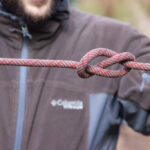Are you curious about where breccia rocks are found and how they fit into landscape design? Breccia, a captivating sedimentary rock featuring angular fragments, offers unique aesthetic and functional possibilities for outdoor spaces. On rockscapes.net, we provide insights into this fascinating stone and its potential for transforming your environment. Discover how breccia’s distinctive textures and colors can enhance your landscaping projects, and uncover expert tips for sourcing and integrating this remarkable stone into your designs.
1. What Exactly Is Breccia Rock?
Breccia rock is a clastic sedimentary rock primarily composed of angular fragments larger than two millimeters in diameter, cemented together by a matrix of finer particles and minerals. The angular shape of the fragments distinguishes breccia from conglomerate, which contains rounded clasts. These rocks tell a story of geological activity and environmental conditions.
- Clastic Sedimentary Rock: Breccia is classified as a clastic sedimentary rock, meaning it is formed from fragments of pre-existing rocks and minerals.
- Angular Fragments: The defining characteristic of breccia is its composition of angular fragments, indicating minimal transport and weathering.
- Matrix and Cement: The spaces between the large fragments are filled with a matrix of smaller particles and a mineral cement, binding the rock together.
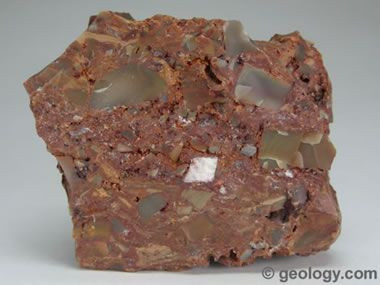 Chert Breccia
Chert Breccia
Chert Breccia: The angular clasts in this breccia are chert fragments, showcasing the sharp edges that define the rock. The matrix is an iron-stained mix of clay- through sand-size particles. The specimen is about two inches (five centimeters) across.
2. How Does Breccia Rock Form?
Breccia forms in environments where angular rock fragments accumulate, typically due to mechanical weathering, debris flows, or tectonic activity. Understanding these formation processes provides insights into the rock’s properties and potential uses.
- Mechanical Weathering: One of the most common locations for breccia formation is at the base of an outcrop, where mechanical weathering debris accumulates.
- Debris Flows: Breccia can also form from debris flow deposits, where poorly sorted material is transported short distances. According to research from Arizona State University’s School of Earth and Space Exploration, debris flows are particularly common in arid and semi-arid regions.
- Tectonic Activity: Fault breccias form in fault zones where rocks are crushed and fragmented by tectonic forces.
3. Where Are Breccia Rocks Typically Found?
Breccia rocks are found in a variety of geological settings around the world, including:
- Mountains: Breccia is often found in mountainous regions, where mechanical weathering and erosion create angular rock fragments.
- Death Valley National Park: Outcrops of breccia can be seen in Death Valley National Park. The largest clasts are about three feet (one meter) across and are thought to be from the Noonday Dolomite.
- Fault Zones: Fault breccias are located along fault lines, where the movement of tectonic plates has crushed and fragmented the rock.
- Volcanic Regions: Igneous breccias are found in volcanic areas, where explosive eruptions and lava flows produce angular rock fragments.
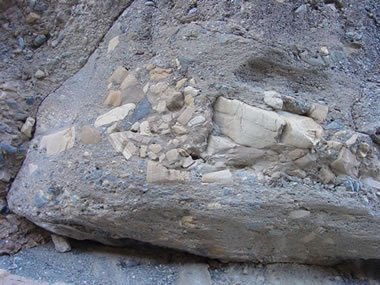 breccia outcrop
breccia outcrop
Debris Flow Breccia: An outcrop of breccia thought to have formed from debris flow deposits in Death Valley National Park, illustrating a classic breccia formation site. The largest clasts are about three feet (one meter) across and are thought to be from the Noonday Dolomite.
4. What Are the Different Types of Breccia?
Breccia rocks are classified based on their origin and composition, including sedimentary breccia, tectonic breccia, volcanic breccia, and impact breccia.
- Sedimentary Breccia: Forms from the accumulation and cementation of angular rock fragments.
- Tectonic Breccia: Forms along fault lines due to the crushing and fragmentation of rocks.
- Volcanic Breccia: Forms from explosive volcanic eruptions or the fragmentation of lava flows.
- Impact Breccia: Forms from the impact of meteorites or asteroids, resulting in shattered and fragmented rock.
5. How Does Breccia Differ From Conglomerate?
Breccia and conglomerate are both clastic sedimentary rocks composed of particles larger than two millimeters in diameter, but they differ in the shape of their clasts. Breccia contains angular fragments, while conglomerate contains rounded clasts.
- Angular vs. Rounded Clasts: The key difference between breccia and conglomerate is the shape of the large particles: angular in breccia, rounded in conglomerate.
- Transport Distance: Angular fragments in breccia indicate minimal transport, while rounded clasts in conglomerate suggest significant transport and abrasion.
- Formation Environment: Breccia typically forms close to the source of the rock fragments, while conglomerate forms in environments with more extensive water transport.
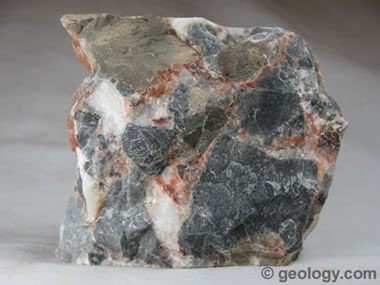 limestone breccia
limestone breccia
Limestone Breccia: This breccia contains clasts of multiple types of limestone, showcasing the variety of materials that can compose a breccia rock. Specimen is about four inches (ten centimeters) across.
6. What Is Breccia’s Composition and Color?
The composition of breccia varies depending on the source rock and the cementing materials. Its color is determined by the matrix, cement, and the fragments themselves, making it a potentially colorful and diverse rock.
- Variable Composition: Breccia composition is primarily determined by the rock and mineral material from which the angular fragments are derived.
- Influence of Climate: The climate of the source area can also affect the composition of breccia, influencing the types of minerals and rock fragments present.
- Color Diversity: The color of breccia is determined by the matrix, cement, and angular rock fragments, resulting in a wide range of potential colors and patterns.
7. What Are the Various Uses of Breccia Rock?
Breccia is used in construction, landscaping, and decorative applications, where its unique appearance and durability make it a valuable material.
- Construction: Breccia can be used as fill or road base in construction projects, although its variable composition can limit its use in critical applications.
- Landscaping: Breccia’s distinctive appearance makes it suitable for use in landscaping, where it can add visual interest and texture to outdoor spaces.
- Architectural Stone: Breccia is used as an architectural stone for interior building veneers, tiles, window sills, and other decorative applications.
- Gemstone: Attractive and interesting pieces of breccia are sometimes used as a gem material, cut into cabochons or other decorative objects.
8. How Is Breccia Used as an Architectural Stone?
Breccia’s unique patterns and colors make it a sought-after architectural stone for interior design, adding character and visual appeal to various surfaces.
- Interior Building Veneers: Breccia is often used as a facing stone for interior walls, providing a distinctive and elegant look.
- Tiles: Breccia tiles can be used for flooring and wall coverings, adding a touch of natural beauty to any space.
- Window Sills: Breccia can be used for window sills, adding a unique and durable element to window design.
- Decorative Applications: Breccia’s unique appearance makes it suitable for various decorative applications, such as countertops, fireplace surrounds, and accent pieces.
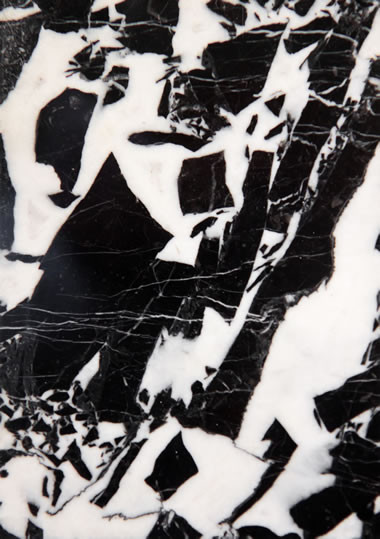 brecciated marble
brecciated marble
Breccia as an Architectural Stone: A large slab of brecciated marble, mined in France, showcases the rock’s suitability for architectural applications, highlighting its unique patterns and colors.
9. Can Breccia Be Used as a Gemstone?
Yes, attractive pieces of breccia can be cut and polished into gemstones, showcasing their unique patterns and colors for jewelry and decorative purposes.
- Cabochons: Breccia is often cut into cabochons, which are polished, rounded gemstones without facets, showcasing the rock’s natural patterns.
- Decorative Objects: Breccia can also be used to create decorative objects, such as sculptures, paperweights, and ornamental pieces.
- Unique Jewelry: Breccia gemstones can be incorporated into unique jewelry designs, adding a touch of natural beauty and geological interest.
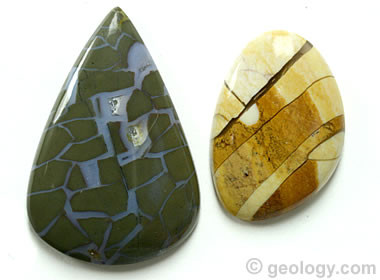 brecciated cabochons
brecciated cabochons
Breccia as a Gemstone: Two cabochons cut from pieces of breccia, illustrating how this rock can be transformed into attractive gemstones. The teardrop-shaped stone is a highly fractured green jasper that was cemented by milky chalcedony. The freeform cabochon is a piece of tan mookaite that shows multiple fractures with displacement. The jasper cab measures 42 mm high by 29 mm wide; the mookaite cabochon measures 32 mm high by 22 mm wide.
10. What Are Some Unique Applications of Breccia in Landscaping?
Breccia can be used in various creative ways in landscaping to add texture, color, and visual interest to outdoor spaces.
- Rock Gardens: Breccia can be used to create rock gardens, where its unique shapes and colors provide a natural and visually appealing backdrop for plants.
- Pathways: Breccia can be used to create pathways and walkways, adding a rustic and textured element to garden design.
- Water Features: Breccia can be incorporated into water features, such as fountains and ponds, adding a natural and geological touch to the design.
- Retaining Walls: Breccia can be used to build retaining walls, providing both structural support and visual interest to terraced landscapes.
11. Where Can You Find High-Quality Breccia for Landscaping Projects in the USA?
Finding high-quality breccia for landscaping projects in the USA requires sourcing from reputable suppliers and quarries known for their superior materials.
- Local Quarries: Begin by researching local quarries in your region. These quarries often offer a variety of breccia types suitable for landscaping, and visiting them allows you to inspect the stone firsthand.
- Stone Suppliers: Stone suppliers specialize in sourcing and distributing natural stones, including breccia. They can provide a wide selection of options, along with expert advice on selecting the right stone for your project.
- Online Marketplaces: Online marketplaces such as rockscapes.net offer a convenient way to browse and purchase breccia from various suppliers. Be sure to check reviews and ratings to ensure you are dealing with a reputable seller.
- Landscape Supply Stores: Landscape supply stores often carry a selection of decorative stones, including breccia. These stores are a good option for smaller projects or for purchasing sample pieces to evaluate the stone’s suitability for your needs.
12. What Should You Consider When Selecting Breccia for Landscape Design?
Selecting the right breccia for your landscape design involves considering factors such as color, texture, size, and durability to ensure it complements your overall design aesthetic and withstands environmental conditions.
- Color: Choose breccia colors that complement the surrounding landscape and architectural elements. Consider the overall color scheme and select stones that enhance the visual appeal of your design.
- Texture: Breccia’s texture can range from rough and jagged to relatively smooth. Select a texture that aligns with the desired aesthetic and functional requirements of your project.
- Size: The size of breccia fragments can vary significantly. Consider the scale of your project and choose fragment sizes that are appropriate for the intended use.
- Durability: Ensure the breccia is durable enough to withstand the environmental conditions in your area. Consider factors such as freeze-thaw resistance, weathering, and resistance to abrasion.
- Source: Source your breccia from reputable suppliers who can provide information on the stone’s origin, composition, and durability. This will help you make an informed decision and ensure the quality of your materials.
13. What Are the Latest Trends in Using Breccia in American Landscape Design?
The latest trends in using breccia in American landscape design focus on incorporating natural, sustainable, and visually striking elements into outdoor spaces.
- Natural Stone Gardens: Breccia is increasingly used in natural stone gardens, where its unique shapes and colors create a harmonious and visually appealing environment.
- Xeriscaping: Breccia is ideal for xeriscaping, a water-wise landscaping approach that utilizes drought-tolerant plants and materials. Its ability to retain moisture and provide habitat for beneficial insects makes it a valuable component of sustainable landscapes.
- Vertical Gardens: Breccia can be incorporated into vertical gardens, adding texture and visual interest to walls and other vertical surfaces. Its porous nature allows for plant roots to attach and thrive, creating living walls that enhance the aesthetic appeal of urban spaces.
- Permeable Paving: Breccia is used in permeable paving applications, allowing rainwater to infiltrate the ground and reducing runoff. This sustainable approach helps to conserve water and reduce the impact of urbanization on local ecosystems.
14. How Can You Integrate Breccia With Other Landscape Materials?
Integrating breccia with other landscape materials requires careful consideration of color, texture, and scale to create a cohesive and visually appealing design.
- Plant Combinations: Pair breccia with plants that complement its colors and textures. Consider drought-tolerant species such as succulents, grasses, and native wildflowers.
- Gravel and Mulch: Use gravel and mulch to fill in spaces between breccia fragments, providing a contrasting texture and helping to retain moisture in the soil.
- Boulders and Rocks: Combine breccia with larger boulders and rocks to create a natural and dynamic landscape. Choose rocks that complement the colors and textures of the breccia.
- Wood and Timber: Incorporate wood and timber elements, such as fences, decks, and planters, to add warmth and contrast to the landscape.
15. What Are Some Maintenance Tips for Breccia Landscapes?
Maintaining breccia landscapes involves regular cleaning, weed control, and occasional repairs to ensure they remain attractive and functional over time.
- Regular Cleaning: Remove debris, leaves, and other organic matter from the surface of the breccia using a broom, leaf blower, or garden hose.
- Weed Control: Control weeds by hand-pulling, applying herbicides, or using landscape fabric to prevent weed growth.
- Repair and Replacement: Inspect the breccia regularly and repair or replace any damaged or missing fragments.
- Sealing: Consider sealing the breccia to protect it from staining and weathering. Choose a sealant that is appropriate for the type of breccia and the environmental conditions in your area.
16. How Can Breccia Contribute to Sustainable Landscaping Practices?
Breccia contributes to sustainable landscaping through its durability, ability to retain moisture, and potential for reducing water consumption.
- Durability: Breccia is a durable material that can withstand the elements, reducing the need for frequent replacement and minimizing waste.
- Moisture Retention: Breccia’s porous nature allows it to retain moisture, reducing the need for frequent watering and conserving water resources.
- Xeriscaping: Breccia is ideal for xeriscaping, a water-wise landscaping approach that utilizes drought-tolerant plants and materials, minimizing water consumption.
- Reduced Runoff: Breccia can be used in permeable paving applications, allowing rainwater to infiltrate the ground and reducing runoff, which helps to recharge groundwater supplies and prevent erosion.
17. What Are the Geological Origins That Impact Breccia’s Use in Landscaping?
Understanding the geological origins of breccia helps in selecting appropriate types for landscaping, considering factors like durability and aesthetic appeal.
- Sedimentary Breccia: Formed from accumulated rock fragments, often found in alluvial fans and debris flow deposits. These are generally suitable for decorative landscaping due to their varied compositions and colors.
- Volcanic Breccia: Created from volcanic eruptions, these breccias can be lightweight and porous, making them useful for drainage in garden beds or as a unique mulch.
- Tectonic Breccia: Resulting from fault lines, these are often highly fractured and may not be as structurally sound for load-bearing applications but can add unique texture to rock gardens.
- Impact Breccia: Formed from meteorite impacts, these are rare but can contain unique mineral compositions, potentially adding distinctive elements to specialized geological gardens.
18. How Does the Local Climate Affect the Choice of Breccia?
The local climate significantly influences the choice of breccia for landscaping, affecting its longevity and aesthetic appeal.
- Freeze-Thaw Cycles: In regions with significant freeze-thaw cycles, it’s essential to select breccia types resistant to cracking and degradation from water expansion.
- Arid Climates: In arid climates, lighter-colored breccias can help reflect sunlight and reduce heat absorption, benefiting nearby plants by moderating soil temperatures.
- Humid Climates: In humid climates, porous breccias can aid in drainage, preventing waterlogged conditions that can harm plant roots.
- Coastal Environments: Coastal environments require breccias that are salt-resistant to avoid erosion and degradation from salt spray.
19. How Can Rockscapes.net Help You Find the Perfect Breccia for Your Project?
Rockscapes.net offers a comprehensive resource for finding the perfect breccia for your landscaping project, providing expert advice, a wide selection of stones, and valuable design inspiration.
- Expert Advice: Our team of experienced landscape designers and geologists can provide expert advice on selecting the right breccia for your project, considering factors such as color, texture, durability, and geological origin.
- Wide Selection of Stones: We offer a wide selection of breccia stones from reputable suppliers and quarries, ensuring you have access to high-quality materials that meet your specific needs.
- Design Inspiration: Our website features a gallery of stunning breccia landscapes, providing inspiration for your own outdoor spaces. Explore our design ideas and discover the endless possibilities of breccia landscaping.
- Supplier Network: We connect you with a network of trusted suppliers and contractors who can help you source and install breccia for your project, ensuring a seamless and successful experience.
20. Frequently Asked Questions (FAQs) About Breccia Rocks
Here are some frequently asked questions about breccia rocks, providing additional insights into their formation, properties, and uses.
- What is the primary difference between breccia and other sedimentary rocks? Breccia stands out due to its large, angular fragments, indicating minimal erosion and transport compared to the rounded grains in conglomerates or the fine particles in sandstones.
- Can breccia be used in high-traffic areas of a landscape? Yes, if the breccia is well-cemented and durable. Choose varieties known for their compressive strength and resistance to weathering.
- How does the matrix material affect the appearance and stability of breccia? The matrix, composed of finer particles and minerals, binds the larger fragments together. Its color and composition greatly influence the overall appearance and the rock’s resistance to weathering.
- Is breccia suitable for use in water features like ponds or fountains? Certain types of breccia can be used, but it’s crucial to select varieties that do not contain minerals that could leach into the water and harm aquatic life.
- How can I clean breccia used in outdoor landscaping? Regular cleaning with a brush and water is usually sufficient. For tougher stains, a mild detergent can be used, but avoid harsh chemicals that could damage the stone.
- What are the best plants to pair with breccia in a rock garden? Drought-tolerant plants such as succulents, sedums, and native grasses pair well with breccia, as they complement its rugged texture and require minimal watering.
- Does breccia affect soil pH? Depending on its composition, breccia can slightly affect soil pH. For example, limestone breccia can raise the pH, which may benefit certain plants but harm others.
- How can I prevent weeds from growing between breccia stones? Using landscape fabric beneath the breccia can help prevent weed growth. Additionally, regular weeding and the application of pre-emergent herbicides can be effective.
- Can breccia be used in retaining walls? Yes, breccia can be used in retaining walls, but it’s important to ensure the stones are structurally sound and properly installed to provide adequate support and stability.
- Where can I find professional help to design a landscape using breccia? Rockscapes.net can connect you with experienced landscape designers and contractors who specialize in working with natural stones like breccia.
Ready to transform your outdoor space with the unique beauty of breccia? Visit rockscapes.net today to explore our extensive collection of breccia stones, discover inspiring design ideas, and connect with our team of experts. Let us help you create a landscape that reflects your personal style and enhances the natural beauty of your property. Contact us at 1151 S Forest Ave, Tempe, AZ 85281, United States or call +1 (480) 965-9011. Visit our website at rockscapes.net for more information and inspiration.
